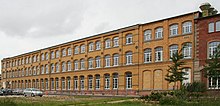Ferdinand Traugott Flinsch
Ferdinand Traugott Flinsch (born August 19, 1792 in Blankenberg / Saale , † November 11, 1849 in Leipzig ) was a German entrepreneur , paper manufacturer and paper dealer.
Life
Ferdinand Traugott Flinsch was the founder of the paper trading houses Flinsch, which were formerly located in various parts of Germany. After attending school in Blankenberg up to the age of 13, he came as an apprentice to a materials store in Hof and in 1806 to a similar shop in Schleiz . Familiar with the nature of paper from his parents' paper mill and, above all, striving for independence, he tried at an early age to do his own business with paper on the side. When Flinsch exchanged his job in Schleiz with a similar one in Leipzig in 1813, he came to the center of the German book trade and was able to conduct his business more intensively.
After spending another year in the Leipzig bank Kistner & Co. and deepening his general knowledge, he went on a trip to Franconia and southern Germany to establish contacts and trade relationships with paper mills. On April 20, 1819, he and his younger brother Heinrich founded the Flinsch paper trading company in Leipzig.
In 1821 the two owners were joined by their brother Carl and the business now grew steadily.
In 1827 a branch was opened in Offenbach am Main to better serve the southern German customers , which was relocated to Frankfurt am Main in 1828 and Heinrich Flinsch took over the management. He moved from Leipzig to Frankfurt and thus became the founder of the southern German tribe of Flinsch, which has its headquarters in Frankfurt am Main and had trading branches under the name Ferdinand Flinsch in Stuttgart, Munich and Düsseldorf.
In order to meet customer demand, Ferdinand Traugott Flinsch decided to start producing paper himself. In 1834 he took over the paper mill in Penig from Gustav Franz Käferstein and had an English paper machine installed there. The invention of the paper machine in 1798 by the French Nicholas-Louis Robert brought about the transition from manual production of paper to industrial production in the first decades of the 19th century.
From 1842 to 1843, Ferdinand Traugott Flinsch, together with his brother Christian, also converted their father's paper mill in Blankenberg , of which he had since become a co-owner, into a machine paper factory. The paper machine installed there had a width of 60 inches (1,525 mm) and also came from England, from the Bryan Donkin company in London. After the renovation, the company employed 70 people and was therefore an important employer in the region.
Ferdinand Traugott Flinsch died on November 11, 1849 in Leipzig at the age of only 57. After his death, the Leipzig business with the paper mills in Blankenberg and Penig passed to his brother Karl, his eldest son Gustav, his daughter and his widow. Another son, Alexander Ferdinand Flinsch , who worked in his parents' business until 1858, later became a watercolor painter and art collector in Berlin.
Flinschstrasse was named after him in the town of Penig. On January 1, 2019, the main street in Blankenberg was renamed Ferdinand-Flinsch-Straße.
literature
- Friedrich W. Süs: The trading house Ferdinand Flinsch: Commemorative book for its 50th anniversary celebration on April 20, 1869. Mahlau & Waldschmidt, Frankfurt am Main 1869. Digitized
- Heino Castorf: The patent paper factory in Penig. A contribution to the history of paper. Wohlfeld, Magdeburg 1897.
- o. V .: The roll of paper. History of paper production in Blankenberg. Commission publisher Ferd. Götze, Lobenstein (Reuss) 1920.
- Hans Georg Kutzner: Flinsch, Ferdinand Traugott. In: New German Biography (NDB). Volume 5, Duncker & Humblot, Berlin 1961, ISBN 3-428-00186-9 , p. 248 f. ( Digitized version ).
Web links
Individual evidence
| personal data | |
|---|---|
| SURNAME | Flinsch, Ferdinand Traugott |
| BRIEF DESCRIPTION | German entrepreneur, paper manufacturer and paper dealer |
| DATE OF BIRTH | August 19, 1792 |
| PLACE OF BIRTH | Blankenberg |
| DATE OF DEATH | November 11, 1849 |
| Place of death | Leipzig |


